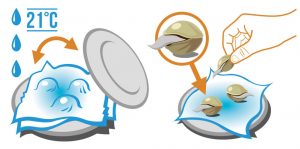
Most medical marijuana growers use cloning methods since it is easier and very user-friendly, whereas growing from seed can be more unpredictable as well as takes more time.
The benefits of starting by seed are that you have the opportunity to see each plant progress through its life cycle and can choose only the best seeds to be your mother plants.
The problem today is that most growers who choose the cloning method have been given their cannabis strain from unreliable sources, claiming they know the genetics of that plant, and in actuality, they don’t have a clue what it is.
With this in mind, choosing to grow marijuana from seed will allow you to know your strain, raising them from seedling to flowering cannabis. Seed germination is the process in which a plant emerges from the seed and for cannabis seeds to germinate, they only need three (3) things:
- Water
- Heat
- Air
Seeds are even able to germinate without the need for light for some time. Seeds that have been taken care of properly can germinate within two (2) to seven (7) days if they are grown in temperatures ranging from 70 – 90°F (21 – 32° C).
Temperatures that are above or below these temperatures will impair the growth of the seeds. When a seed has germinated the outside shell coating splits and a tiny white sprout (radicle) pops out, this is the root or taproot, which will begin to develop the root system.
Cotyledon, or seed, grows upward with the seed shell pushed upward towards the surface in search of light.
Using Water to Germinate Cannabis Seeds

By soaking cannabis seeds in water it allows moisture to penetrate the seed’s shell very quickly then the moisture can penetrate the shell it begins to activate the seed’s dormant hormones.
Throughout the germination process, until the seed begins to sprout the seed will continuously absorb more moisture to supply what it needs to grow. If the seeds do not seem to be taking in water or sprouting, it could be due to the seed having a very hard shell.
In this case, many people use the technique called scarifying the seed. This process is done by taking a very fine-grain piece of sandpaper or emery board and very lightly scratching the seed’s shell to scuff it.
If you scratch too hard, you run the risk of ruining the seed, but some people use small matchboxes and glue a piece of fine-grain sandpaper or emery board to the bottom of the matchbox.
Then place the seeds inside of the box and put them on the cover of the box then shakes for 30 seconds. This process will allow water to be able to penetrate the shell’s very hard exterior and permit germination to take place.
Within several days from the initial hormone activation, when activated and send signals to other hormones they start producing a radicle.  The radicle that is produced begins to grow and sprout that will grow.
The radicle that is produced begins to grow and sprout that will grow.
For the seed to continue to grow, it will consistently bring up moisture to transport nutrients, hormones, and water through the root system to be able to develop.
Moisture is the key to this part of the seed’s life so if the seed is deprived of moisture then the seed will soon die.
Most city and well waters have enough dissolved solids (food and salts) that can nourish a cannabis seed throughout its first several weeks of life. After which they will then need additional fertilizer to thrive.
Seeds need only 30 – 50 parts-per-million (PPM) of nitrates before they germinate, any more than that will mess with their chemistry. It is always best to play it safe and not add any more than needed, but a problem that many people run into is that there are too many dissolved salts within the water that they are using for germination.
When there are too many dissolved salts in the water, it will begin to pull moisture out of the seed instead of supplying water to the seed. If this is of concern, grab a sample of your water and take it in to get tested.
When the seedling is about two (2) to four (4) weeks old, you may begin to add fertilizer in with the water, starting at a low dosage of a quarter-strength or so, and build up as necessary. It is better to under-fertilize than over-fertilize.
If the plants begin to turn yellow, you may increase the dosage and if leaves start to burn you are adding too much fertilizer to your water.
Let us know what you think.




Responses